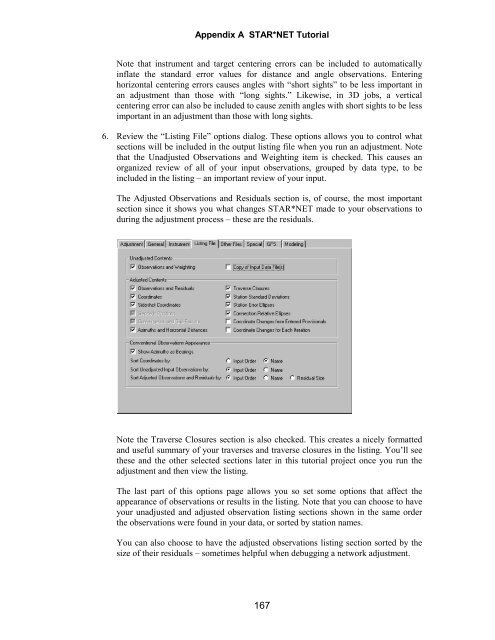STAR*NET V6 - Circe
STAR*NET V6 - Circe
STAR*NET V6 - Circe
You also want an ePaper? Increase the reach of your titles
YUMPU automatically turns print PDFs into web optimized ePapers that Google loves.
Appendix A <strong>STAR*NET</strong> Tutorial<br />
Note that instrument and target centering errors can be included to automatically<br />
inflate the standard error values for distance and angle observations. Entering<br />
horizontal centering errors causes angles with “short sights” to be less important in<br />
an adjustment than those with “long sights.” Likewise, in 3D jobs, a vertical<br />
centering error can also be included to cause zenith angles with short sights to be less<br />
important in an adjustment than those with long sights.<br />
6. Review the “Listing File” options dialog. These options allows you to control what<br />
sections will be included in the output listing file when you run an adjustment. Note<br />
that the Unadjusted Observations and Weighting item is checked. This causes an<br />
organized review of all of your input observations, grouped by data type, to be<br />
included in the listing – an important review of your input.<br />
The Adjusted Observations and Residuals section is, of course, the most important<br />
section since it shows you what changes <strong>STAR*NET</strong> made to your observations to<br />
during the adjustment process – these are the residuals.<br />
Note the Traverse Closures section is also checked. This creates a nicely formatted<br />
and useful summary of your traverses and traverse closures in the listing. You’ll see<br />
these and the other selected sections later in this tutorial project once you run the<br />
adjustment and then view the listing.<br />
The last part of this options page allows you so set some options that affect the<br />
appearance of observations or results in the listing. Note that you can choose to have<br />
your unadjusted and adjusted observation listing sections shown in the same order<br />
the observations were found in your data, or sorted by station names.<br />
You can also choose to have the adjusted observations listing section sorted by the<br />
size of their residuals – sometimes helpful when debugging a network adjustment.<br />
167

















